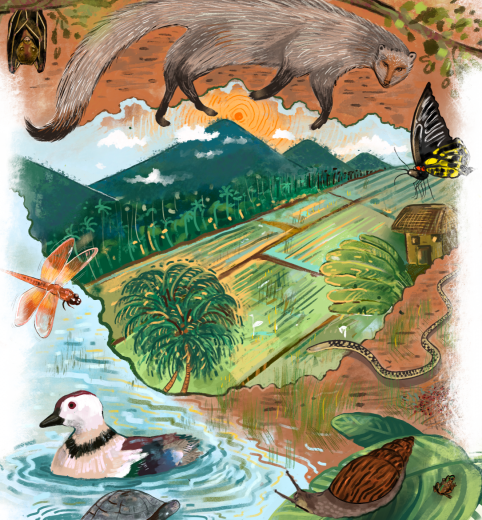Editor’s Note
As the Covid-19 crisis continues to unfold and impact our lives, we would like to offer you an escape between these pages. Our first stop is the lush forests of the Eastern Himalayas, where Ambika Aiyadurai and Mamata Pandya recount what happened once, a long, long time ago, when there was a tug of war between a mountain spirit and the Idu Mishmi people from Arunachal Pradesh, India. Heading west from there, Simon Pooley helps us rethink coexistence with wildlife—of the crocodilian kind—in the wetlands of Gujarat. Moving down south to the Western Ghats and in keeping with the reptilian theme, Udita Bansal reminds us that while roads serve to connect people, they are a major cause of snake mortality when they cut through forests. Further south, amidst the vanishing midland paddy fields of Kerala, Manju Vasudevan Sharma and Sreeja KG draw our attention to this seemingly unlikely sanctuary of floral and faunal biodiversity.
Then, in a couple of charming Field Notes, Daniel J. Read narrates an encounter with a common krait in his bathroom, and Bhavya Iyer notes how an obsession with spotting tigers might mean missing out on everything else the forest has to offer. Manya Kotera’s Research in Translation piece offers insights into the cultural and environmental perspectives of sacred groves and the crucial role played by local communities in their protection. Finally, this issue brings us two columns—one where the infamous Kartel Shockington receives letters from barnacles, anemone fish, deer, and several others, voicing their concerns over Nature and her ways; and a second column, in which Anusha Shankar, using the analogy of a tree, delves into the messy world of conservation careers and how they can be tended to and shaped.
We are delighted to present the first issue of Current Conservation of the year, which also happens to be my first as the Executive Editor. Undoubtedly, the most riveting part of the process for me was watching each article come to life through art— especially as someone who thinks in words. I can now test to the magazine being a platform where art meets science.
—Devathi Parashuram
We bid farewell to Ankila Hiremath, who is a Founding Editor, and has been involved with CC from the very beginning. In addition to her editorial skills, Ankila brought a calm presence, thoughtful comments and general warmth to the team which we will greatly miss. We are also bidding farewell to Matthew Creasey, who worked closely with Ankila in launching and running CC Kids. Thanks Ankila and Matt for all that you have done for the magazine.
—Kartik Shanker









